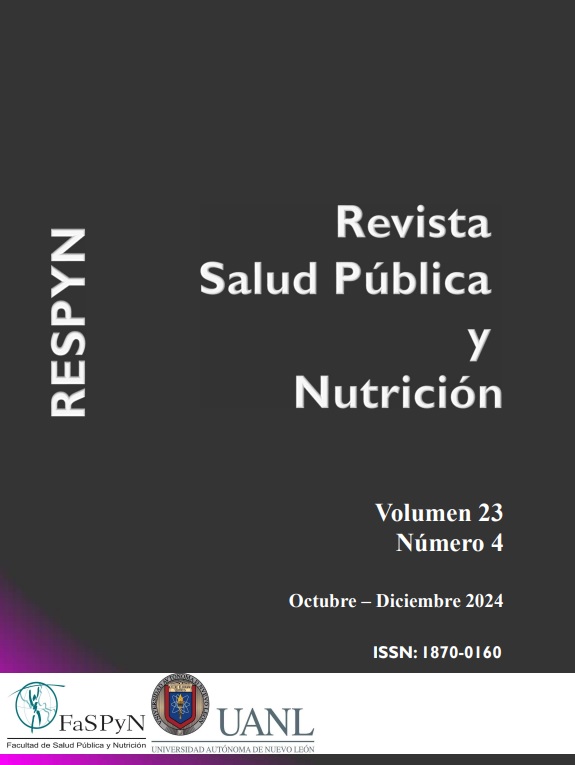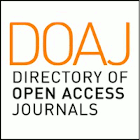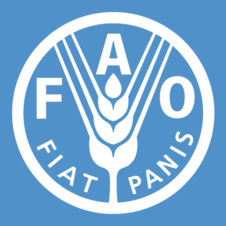Edulcorantes no calóricos en exceso de peso: aplicación en matrices lácteas.
DOI:
https://doi.org/10.29105/respyn23.4-827Palabras clave:
edulcorantes, edulcorantes artificiales, yogur, obesidad, productos lácteosResumen
Introducción: El uso de edulcorantes ha aumentado mucho en las últimas décadas debido a la preocupación por los efectos negativos del consumo excesivo de azúcar, asociado con enfermedades crónicas no transmisibles. Objetivo: Esta revisión examina la evidencia sobre los edulcorantes no calóricos (sucralosa, sacarina, aspartame, acesulfame K, neotame, advantame, ciclamato, lactitol y estevia) y su relación con el exceso de peso, además de sus ventajas y desventajas tecnológicas en la producción de yogur. Material y Método: Se realizó una revisión de tema con base a la literatura publicada entre los años 2018 a 2023 en las bases de datos Science Direct, PubMed y Google Scholar. Resultados: La sacarina, sucralosa, acesulfame K y advantame activan el sistema de recompensa, mientras que la sucralosa y la sacarina provocan disbiosis intestinal. Por otro lado, la estevia y el lactitol son los más adecuados para la producción industrial de yogur debido a su estabilidad en pH ácidos, solubilidad en agua y resistencia al calor. Conclusión: La estevia destaca como el edulcorante más apropiado, ya que combina ventajas tecnológicas con la ausencia de efectos negativos para la salud.
Descargas
Citas
Dergal, Badui, S. (2020). Química de los alimentos. 6ta edición. Pearson education.
Farhat, G., Berset, V., & Moore, L. (2019). Effects of Stevia Extract on Postprandial Glucose Response, Satiety and Energy Intake: A Three-Arm Crossover Trial. Nutrients, 11(12), 3036. https://doi.org/10.3390/nu11123036 DOI: https://doi.org/10.3390/nu11123036
Finney, M., Smullen, J., Foster, H. A., Brokx, S., & Storey, D. M. (2007). Effects of low doses of lactitol on faecal microflora, pH, short chain fatty acids and gastrointestinal symptomology. European Journal of Nutrition, 46(6), 307-314. https://doi.org/10.1007/s00394-007-0666-7 DOI: https://doi.org/10.1007/s00394-007-0666-7
Flora, T. (2018). The Prevalence, Consumption, and Overall Health Effects of Nonnutritive Sweeteners. Proceedings of Student Research and Creative Inquiry Day, 2. https://publish.tntech.edu/index.php/PSRCI/article/view/254
Ghusn, W., Naik, R., Yibirin, M., Ghusn, W., Naik, R., & Yibrin, M. (2023). The Impact of Artificial Sweeteners on Human Health and Cancer Association: A Comprehensive Clinical Review. Cureus, 15(12). ttps://doi.org/10.7759/CUREUS.51299 DOI: https://doi.org/10.7759/cureus.51299
Gjermeni, E., Kirstein, A. S., Kolbig, F., Kirchhof, M., Bundalian, L., Katzmann, J. L., Laufs, U., Blüher, M., Garten, A., & Le Duc, D. (2021). Obesity–An Update on the Basic Pathophysiology and Review of Recent Therapeutic Advances. Biomolecules, 11(10), 1426. https://doi.org/10.3390/biom11101426 DOI: https://doi.org/10.3390/biom11101426
Gomes, A., Bourbon et.al, (2023). Strategies for the reduction of sugar in food products. Food Structure Engineering and Design for Improved Nutrition, Health and Well-Being, 219–241. https://doi.org/10.1016/B978-0-323-85513-6.00008-6 DOI: https://doi.org/10.1016/B978-0-323-85513-6.00008-6
Gómez, F. R., Guerrero, C. E. D., & Bernal, G. B. (2014). Documento técnico. Azucares adicionados. https://n9.cl/qh9u1
Gómez-Fernández, A. R., Santacruz, A., & Jacobo-Velázquez, D. A. (2021). The complex relationship between metabolic syndrome and sweeteners. Journal of Food Science, 86(5), 1511-1531. https://doi.org/10.1111/1750-3841.15709 DOI: https://doi.org/10.1111/1750-3841.15709
Grembecka, M. (2019). Sugar Alcohols. Encyclopedia of Food Chemistry (pp. 265-275). Academic Press. https://doi.org/10.1016/B978-0-08-100596-5.21625-9 DOI: https://doi.org/10.1016/B978-0-08-100596-5.21625-9
Higgins, K. A., & Mattes, R. D. (2019). A randomized controlled trial contrasting the effects of 4 low-calorie sweeteners and sucrose on body weight in adults with overweight or obesity. The American Journal of Clinical Nutrition, 109(5), 1288-1301. https://doi.org/10.1093/ajcn/nqy381 DOI: https://doi.org/10.1093/ajcn/nqy381
Islam, M. M., Islam, M. M., Rahman, M. A., Ripon, M. A. R., & Hossain, M. S. (2023). Gut microbiota in obesity and related complications: Unveiling the complex interplay. Life Sciences, 334, 122211. https://doi.org/10.1016/J.LFS.2023.122211 DOI: https://doi.org/10.1016/j.lfs.2023.122211
Jin, X., Qiu, T., Li, L., Yu, R., Chen, X., Li, C., Proud, C. G., & Jiang, T. (2023). Pathophysiology of obesity and its associated diseases. Acta Pharmaceutica Sinica B, 13(6), 2403-2424. https://doi.org/10.1016/j.apsb.2023.01.012 DOI: https://doi.org/10.1016/j.apsb.2023.01.012
Kossiva, L., Kakleas, K., Christodouli, F., Soldatou, A., Karanasios, S., & Karavanaki, K. (2024). Chronic Use of Artificial Sweeteners: Pros and Cons. Nutrients 2024, Vol. 16, Page 3162, 16(18), 3162. https://doi.org/10.3390/NU16183162 DOI: https://doi.org/10.3390/nu16183162
Kumar, M., Kaushik, D., Kaur, J., Proestos, C., Oz, F., Oz, E., Gupta, P., Kundu, P., Kaur, A., Anisha, A., & Ritika, R. (2022). A Critical Review on Obesity: Herbal Approach, Bioactive Compounds, and Their Mechanism. Applied Sciences, 12(16), Article 16. https://doi.org/10.3390/app12168342 DOI: https://doi.org/10.3390/app12168342
Lee, A. A., & Owyang, C. (2019). Chapter 16—Sugars, sweet taste receptors, and brain responses. En V. B. Patel (Ed.), Molecular Nutrition: Carbohydrates (pp. 265-283). Academic Press. https://doi.org/10.1016/B978-0-12-849886-6.00020-3 DOI: https://doi.org/10.1016/B978-0-12-849886-6.00020-3
Lin, C.-H., Li, H.-Y., Wang, S.-H., Chen, Y.-H., Chen, Y.-C., & Wu, H.-T. (2021). Consumption of Non-Nutritive Sweetener, Acesulfame Potassium Exacerbates Atherosclerosis through Dysregulation of Lipid Metabolism in ApoE-/- Mice. Nutrients, 13(11), 3984. https://doi.org/10.3390/nu13113984 DOI: https://doi.org/10.3390/nu13113984
Liu, C.-C., Ko, C.-H., Fu, L.-M., & Jhou, Y.-L. (2023). Light-shading reaction microfluidic PMMA/paper detection system for detection of cyclamate concentration in foods. Food Chemistry, 400, 134063. https://doi.org/10.1016/j.foodchem.2022.134063 DOI: https://doi.org/10.1016/j.foodchem.2022.134063
Lizuka, K. (2022). Is the Use of Artificial Sweeteners Beneficial for Patients with Diabetes Mellitus? The Advantages and Disadvantages of Artificial Sweeteners. Nutrients, 14(21), 4446. https://doi.org/10.3390/nu14214446 DOI: https://doi.org/10.3390/nu14214446
Mandal, P., Rai, A., Mishra, S., Tripathi, A., & Das, M. (2018). Chapter Seven—Mutagens in Food. En A. Kumar, V. N. Dobrovolsky, A. Dhawan, & R. Shanker (Eds.), Mutagenicity: Assays and Applications (pp. 133-160). Academic Press. https://doi.org/10.1016/B978-0-12-809252-1.00007-9 DOI: https://doi.org/10.1016/B978-0-12-809252-1.00007-9
Manzur-Jattin, F., Morales-Núñez, M., Ordosgoitia-Morales, J., Quiroz-Mendoza, R., Ramos-Villegas, Y., Corrales-Santander, H., Manzur-Jattin, F., Morales-Núñez, M., Ordosgoitia-Morales, J., Quiroz-Mendoza, R., Ramos-Villegas, Y., & Corrales-Santander, H. (2020). Impacto del uso de edulcorantes no calóricos en la salud cardiometabólica. Revista Colombiana de Cardiología, 27(2), 103-108. https://doi.org/10.1016/j.rccar.2019.11.003 DOI: https://doi.org/10.1016/j.rccar.2019.11.003
Marti, A., Calvo, C., Martínez, A., Marti, A., Calvo, C., & Martínez, A. (2021). Consumo de alimentos ultraprocesados y obesidad: Una revisión sistemática. Nutrición Hospitalaria, 38(1), 177-185. https://doi.org/10.20960/nh.03151 DOI: https://doi.org/10.20960/nh.03151
Martínez-Monteagudo, S. I., Enteshari, M., & Metzger, L. (2019). Lactitol: Production, properties, and applications. Trends in Food Science & Technology, 83, 181-191. https://doi.org/10.1016/j.tifs.2018.11.020 DOI: https://doi.org/10.1016/j.tifs.2018.11.020
McCain, H. R., Kaliappan, S., & Drake, M. A. (2018). Invited review: Sugar reduction in dairy products. Journal of Dairy Science, 101(10), 8619-8640. https://doi.org/10.3168/jds.2017-14347 DOI: https://doi.org/10.3168/jds.2017-14347
Mennella, I. (2019). Energy Balance and Body Weight Control. En P. Ferranti, E. M. Berry, & J. R. Anderson (Eds.), Encyclopedia of Food Security and Sustainability (pp. 374-377). Elsevier. https://doi.org/10.1016/B978-0-08-100596-5.22147-1 DOI: https://doi.org/10.1016/B978-0-08-100596-5.22147-1
MINSALUD. (2021). Obesidad, un factor de riesgo en el covid-19. https://www.minsalud.gov.co/Paginas/Obesidad-un-factor-de-riesgo-en-el-covid-19.aspx
Nagaoka, S. (2019). Yogurt Production. Methods in Molecular Biology (Clifton, N.J.), 1887, 45-54. https://doi.org/10.1007/978-1-4939-8907-2_5 DOI: https://doi.org/10.1007/978-1-4939-8907-2_5
Nugraheni, R. A. (2022). Effect Of Administration Of Sodium Cyclate (C6h12nnao3s) On The Number Of Polymorfonuclear Cells (PMN) In Rats (Rattus Norvegicus). Jurnal Biosains Pascasarjana, 24(1), Article 1. https://doi.org/10.20473/jbp.v24i1.2022.50-55 DOI: https://doi.org/10.20473/jbp.v24i1.2022.50-55
Page, M. J., McKenzie, J. E., Bossuyt, P. M., Boutron, I., Hoffmann, T. C., Mulrow, C. D., Shamseer, L., Tetzlaff, J. M., Akl, E. A., Brennan, S. E., Chou, R., Glanville, J., Grimshaw, J. M., Hróbjartsson, A., Lalu, M. M., Li, T., Loder, E. W., Mayo-Wilson, E., McDonald, S., … Moher, D. (2021). The PRISMA 2020 statement: an updated guideline for reporting systematic reviews. BMJ, 372. https://doi.org/10.1136/BMJ.N71 DOI: https://doi.org/10.1136/bmj.n71
Richardson, I. L., & Frese, S. A. (2022). Non-nutritive sweeteners and their impacts on the gut microbiome and host physiology. Frontiers in Nutrition, 9, 988144. https://doi.org/10.3389/fnut.2022.988144 DOI: https://doi.org/10.3389/fnut.2022.988144
Rother, K. I., Conway, E. M., & Sylvetsky, A. C. (2018). How Non-nutritive Sweeteners Influence Hormones and Health. Trends in Endocrinology & Metabolism, 29(7), 455-467. https://doi.org/10.1016/j.tem.2018.04.010 DOI: https://doi.org/10.1016/j.tem.2018.04.010
Ruiz-Ojeda, F. J., Plaza-Díaz, J., Sáez-Lara, M. J., & Gil, A. (2019). Effects of Sweeteners on the Gut Microbiota: A Review of Experimental Studies and Clinical Trials. Advances in Nutrition (Bethesda, Md.), 10(suppl_1), S31-S48. https://doi.org/10.1093/advances/nmy037 DOI: https://doi.org/10.1093/advances/nmy037
Samaniego-Vaesken, M. de L., Partearroyo, T., Cano, A., Urrialde, R., & Varela-Moreiras, G. (2019). Novel database of declared low- and no-calorie sweeteners from foods and beverages available in Spain. Journal of Food Composition and Analysis, 82, 103234. https://doi.org/10.1016/j.jfca.2019.103234 DOI: https://doi.org/10.1016/j.jfca.2019.103234
Sarma, S., Sockalingam, S., & Dash, S. (2021). Obesity as a multisystem disease: Trends in obesity rates and obesity-related complications. Diabetes, Obesity & Metabolism, 23 Suppl 1, 3-16. https://doi.org/10.1111/dom.14290 DOI: https://doi.org/10.1111/dom.14290
Schardt, C., Adams, M. B., Owens, T., Keitz, S., & Fontelo, P. (2007). Utilization of the PICO framework to improve searching PubMed for clinical questions. BMC Medical Informatics and Decision Making, 7. https://doi.org/10.1186/1472-6947-7-16 DOI: https://doi.org/10.1186/1472-6947-7-16
Sheikh, A. B., Nasrullah, A., Haq, S., Akhtar, A., Ghazanfar, H., Nasir, A., Afzal, R. M., Bukhari, M. M., Chaudhary, A. Y., & Naqvi, S. W. (2017). The Interplay of Genetics and Environmental Factors in the Development of Obesity. Cureus, 9(7), e1435. https://doi.org/10.7759/cureus.1435 DOI: https://doi.org/10.7759/cureus.1435
Tack, J., Verbeure, W., Mori, H., Schol, J., Van den Houte, K., Huang, I., Balsiger, L., Broeders, B., Colomier, E., Scarpellini, E., & Carbone, F. (2021). The gastrointestinal tract in hunger and satiety signalling. United European Gastroenterology Journal, 9(6), 727-734. https://doi.org/10.1002/ueg2.12097 DOI: https://doi.org/10.1002/ueg2.12097
Tiefenbacher, K. F. (2017). Chapter Three—Technology of Main Ingredients—Sweeteners and Lipids. En K. F. Tiefenbacher (Ed.), Wafer and Waffle (pp. 123-225). Academic Press. https://doi.org/10.1016/B978-0-12-809438-9.00003-X DOI: https://doi.org/10.1016/B978-0-12-809438-9.00003-X
Toews, I., Lohner, S., Küllenberg de Gaudry, D., Sommer, H., & Meerpohl, J. J. (2019). Association between intake of non-sugar sweeteners and health outcomes: Systematic review and meta-analyses of randomised and non-randomised controlled trials and observational studies. The BMJ, 364, k4718. https://doi.org/10.1136/bmj.k4718 DOI: https://doi.org/10.1136/bmj.k4718
Wan, Z., Khubber, S., Dwivedi, M., & Misra, N. N. (2021). Strategies for lowering the added sugar in yogurts. Food Chemistry, 344, 128573. https://doi.org/10.1016/j.foodchem.2020.128573 DOI: https://doi.org/10.1016/j.foodchem.2020.128573
WHO. (1981). Aspartame. https://apps.who.int/food-additives-contaminants-jecfa-database/Home/Chemical/62
WHO. (1990). Sacarina. https://apps.who.int/food-additives-contaminants-jecfa-database/Home/Chemical/3164
WHO. (1996a). Acesulfamo de potasio. https://apps.who.int/food-additives-contaminants-jecfa-database/Home/Chemical/926
WHO. (1996b). Ácido cliclámico. https://apps.who.int/food-additives-contaminants-jecfa-database/Home/Chemical/995
WHO. (1996c). Lactitol. https://apps.who.int/food-additives-contaminants-jecfa-database/Home/Chemical/3084
WHO. (2001). Sucralosa. https://apps.who.int/food-additives-contaminants-jecfa-database/Home/Chemical/2340
WHO. (2007). Glocósidos de esteviol. https://apps.who.int/food-additives-contaminants-jecfa-database/Home/Chemical/267
WHO. (2013). Advantame. https://apps.who.int/food-additives-contaminants-jecfa-database/Home/Chemical/6181
WHO. (2023). Neotame. https://apps.who.int/food-additives-contaminants-jecfa-database/Home/Chemical/5107
WHO. (2018). Obesidad y sobrepeso. https://www.who.int/es/news-room/fact-sheets/detail/obesity-and-overweight
Wilk, K., Korytek, W., Pelczyńska, M., Moszak, M., & Bogdański, P. (2022). The Effect of Artificial Sweeteners Use on Sweet Taste Perception and Weight Loss Efficacy: A Review. Nutrients, 14(6), 1261. https://doi.org/10.3390/nu14061261 DOI: https://doi.org/10.3390/nu14061261
Xiao, R., Lei, C., Zhang, Y., & Zhang, M. (2023). Interleukin-6 in retinal diseases: From pathogenesis to therapy. Experimental Eye Research, 233, 109556. https://doi.org/10.1016/j.exer.2023.109556 DOI: https://doi.org/10.1016/j.exer.2023.109556
Zemel, M. B. (2009). Proposed Role of Calcium and Dairy Food Components in Weight Management and Metabolic Health. The Physician and Sportsmedicine, 37(2), 29–39. https://doi.org/10.3810/PSM.2009.06.1707 DOI: https://doi.org/10.3810/psm.2009.06.1707
Zhang, J. Y., Zhang, J. B., Yu, H. Y., Yong, L., Zhang, H., Wang, H. L., & Weng, Y. X. (2019). Theoretical Risk Assessment of Dietary Exposure to Advantame among the Chinese Population. Biomedical and Environmental Sciences, 32(12), 930-933. https://doi.org/10.3967/bes2019.117
Zhou, Q., Wang, Y., Lu, Z., He, C., Li, L., You, M., Wang, L., Cao, T., Zhao, Y., Li, Q., Mou, A., Shu, W., He, H., Zhao, Z., Liu, D., Zhu, Z., Gao, P., & Yan, Z. (2023). Cx43 acts as a mitochondrial calcium regulator that promotes obesity by inducing the polarization of macrophages in adipose tissue. Cellular Signalling, 105, 110606. https://doi.org/10.1016/j.cellsig.2023.110606 DOI: https://doi.org/10.1016/j.cellsig.2023.110606
Descargas
Publicado
Cómo citar
Número
Sección
Licencia
Derechos de autor 2024 María Antonia Sanchez Londoño, Ana Rosa Ramos Polo

Esta obra está bajo una licencia internacional Creative Commons Atribución 4.0.
Los derechos del trabajo pertenecen al autor o autores, sin embargo, al enviarlo a publicación en la Revista Salud Pública y Nutrición de la Facultad de Salud Pública y Nutrición de la Universidad Autónoma de Nuevo León, le otorgan el derecho para su primera publicación en medio electrónico, y posiblemente, en medio impreso a la Revista Salud Pública y Nutrición. La licencia que se utiliza es la de atribución de Creative Commons , que permite a terceros utilizar lo publicado siempre que se mencione la autoría del trabajo y a la primera publicación que es en la Revista Salud Pública y Nutrición. Asimismo, el o los autores tendrán en cuenta que no estará permitido enviar la publicación a ninguna otra revista, sin importar el formato. Los autores estarán en posibilidad de realizar otros acuerdos contractuales independientes y adicionales para la distribución no exclusiva de la versión del artículo publicado en la Revista Salud Pública y Nutrición (p. ej., repositorio institucional o publicación en un libro) siempre que indiquen claramente que el trabajo se publicó por primera vez en la Revista Salud Pública, Revista de la Facultad de Salud Pública y Nutrición de la Universidad Autónoma de Nuevo León.














